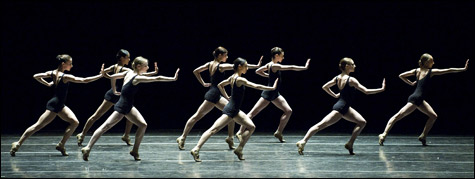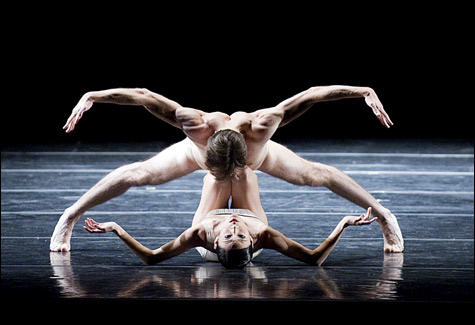
FALLING ANGELS: For women only, it's the Eleusinian Mysteries of dance.
|
Czech choreographer/Nederlands Dans Theater director Jirí Kylián made his Black & White Ballets out of five pieces — No More Play, Petite Mort, Sarabande, Falling Angels, and Sechs Tänze — he’d created between 1986 and 1991, and it’s an unnerving investigation of sexual politics and sexual identity, now dark, now goofy. Kylián’s brand of Eurotheater hasn’t always been popular with critics on this side of the Pond, but this past weekend, when Boston Ballet became the first company outside the Netherlands to perform the complete Black & White, Wang Theatre audiences ate it up. So much for the notion that Boston is interested only in classical story ballets.

Kylián’s unifying device is a set of formal, mostly black, late-18th-century dresses, just the bodice and the full skirt, hung on a framework with rollers. The dancers, men as well as women, pop up from behind them and pose, push them on and off stage. During Sarabande, the dresses rise and hover above the dancers. Kylián also makes use of foils in Petite Mort, and the operatic shenanigans of Sechs Tänze, which is set to Mozart’s K.571 German Dances, are presented in period undergarments and powdered wigs and chalky make-up. The choreography, whose many repeating tropes also unify the set, is so spiky and so charged, the props are almost a distraction.
Set to Anton Webern’s savage, shadowy Five Movements for Strings, No More Play began Thursday with Sabi Varga standing behind Yury Yanowsky and holding his hands in front of Yanowsky’s eyes and stomach, as if he were the Elegy Angel from Balanchine’s Serenade; meanwhile, stage left, Lorna Feijóo, Nelson Madrigal, and Kathleen Breen Combes moved in lockstep like marionettes. This one’s in edgy twos and threes. During the nocturnal second movement, Breen Combes stands on Varga’s thighs and pulls him up, and later she stands on the back of his knee and does an arabesque. In the last movement, Feijóo and Madrigal sit at the front of the stage with their legs dangling over the edge and cast huge shadows on the back wall. At the end, all five sit facing away from us and then lie back, heads hanging over the edge of the stage. It’s a community — but unlike those of Twyla Tharp and Mark Morris, it’s not one we’re invited to join.

PETITE MORT: The title may mean orgasm, but Rie Ichikawa keeps Roman Rykine at a distance.
|
Petite Mort (French slang for “orgasm”) opens with six men in flash-toned corset briefs backing toward us, each balancing a foil on his right index finger. They swish the foils, roll them around on the floor with a toe, execute a kind of rifle drill. Eventually six women come forward behind the dresses and make love to them. We get, one by one, six duets; on more than one occasion, a man’s descent into his partner is blocked by her knees and he floats on them. The gorgeous slow movements from Mozart’s Piano Concertos Nos. 23 and 21 counterpoint the jousting. At the end, five of the six dresses are rolled from the wings toward center stage.
In Sarabande and Falling Angels (which Boston Ballet presented in March 2005, to lesser effect), men and women part company. The six men of Sarabande, who’re miked (in the hovering dresses; the only other sound, toward the end, is the title section of Bach’s Violin Partita No. 2), go primate/primal: breathing, doing yoga and pilates, crawling, creeping, swimming, flopping, deflating, bicycling, finger-pointing, whistling, clucking, slinging their undershirts about, pulling their trousers down, offering individual solos, finishing with a cacophony of screams. The eight women of Falling Angels (to the first part of Steve Reich’s Drumming) sashay, dribble, wiggle, waggle their hands, tug at their shirts, run in place, execute solos, put their hands to their mouths or over their ears, get pregnant, and give birth before finishing in an attitude of (petite) mort.
Where do men and women go after getting back in touch with being men and women? To a Mozart opera, Figaro or Cosí fan tutte (though Lorna Feijóo’s pleading with Pavel Gurevich suggests rather Tosca). There’s no end of hanky-panky in the six teasing skirt swishers and tuggers of Sechs Tänze. When she’s bumped out of a trio, Erica Cornejo sits and waves ingratiatingly to the audience before being retrieved. Feijóo is the center of a tug of war between Gurevich and Altankhuyag Dugaraa until they discover . . . dresses, leaving her to stalk off in high dudgeon. Boyko Dossev and Lorin Mathis, as two of the five non-dancing “megastars,” exit opposite in a snit after discovering they’re wearing the same dress; James Whiteside later turns up with one of those foils and slices Dossev’s head off. When Dossev steps out from behind his dress in a fig leaf, Jared Redick and Krista Ettlinger swoon and have to be revived by their partners. Dugaraa looks delighted with his fish-dive position in Gurevich’s arms until he realizes he’s in a girl’s pose. Soap bubbles mingle with the powder at the end, the dancers backing away from the audience in mingled awe and apprehension. Feijóo tries to catch the bubbles in her skirt; Parrondo blows kisses at the audience.